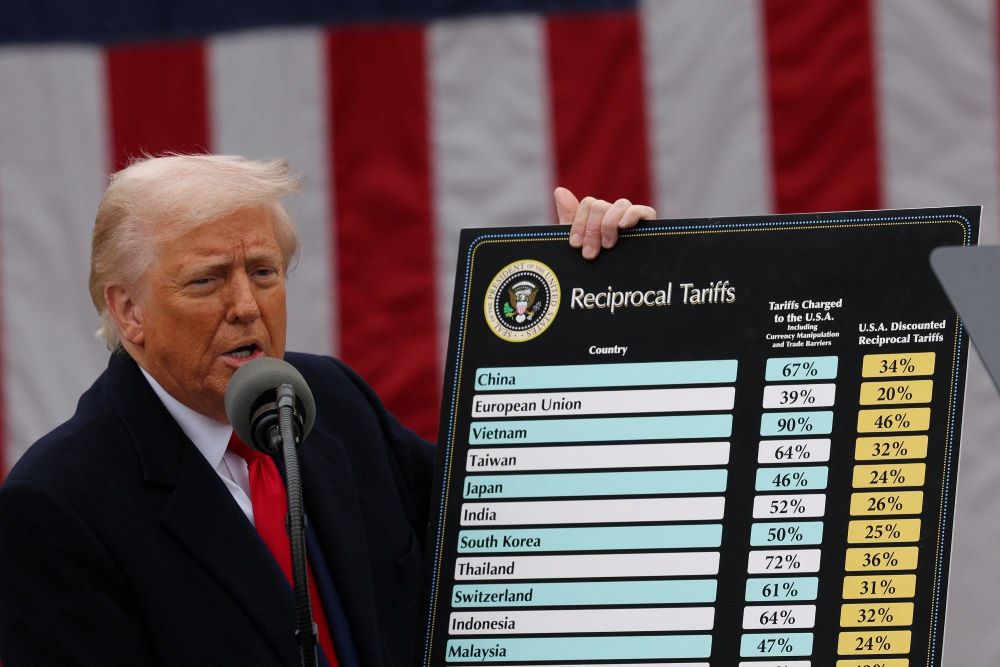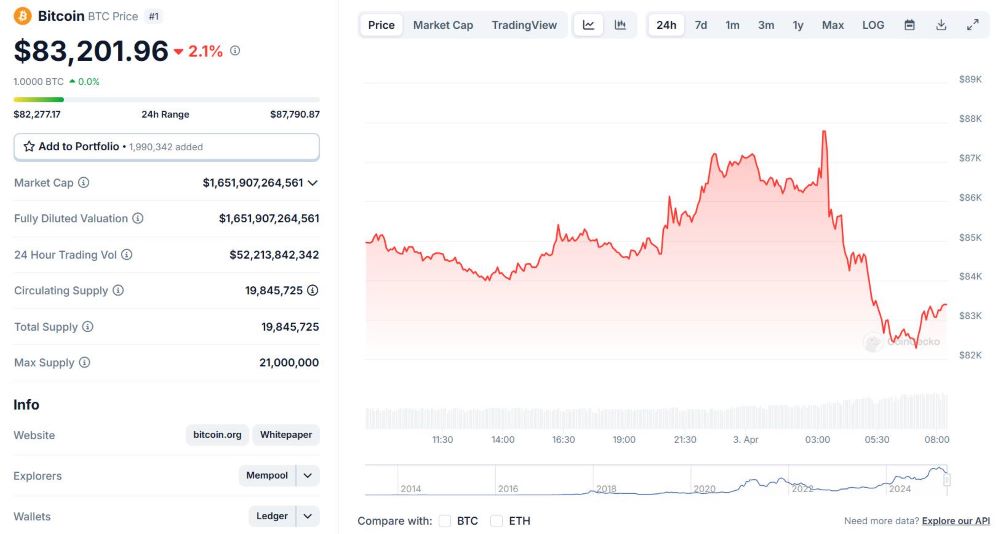On April 2, 2025 (U.S. time), President Donald Trump officially announced tariffs on numerous countries that the U.S. believes have contributed to the prolonged trade deficit. This move not only marks a significant shift in Trump’s economic policies but also sent shockwaves through global financial markets, with Bitcoin and major stock indices plummeting. Below are the full details of this event.
Contents
Retaliatory tariffs: Trump’s “liberation day”

During a press conference at the White House, President Trump signed an executive order to implement retaliatory tariffs, fulfilling his “Liberation Day” promise made in March 2025. According to the announcement, all goods imported into the U.S. will be subject to a standard 10% tariff, effective April 5, 2025. However, countries with large trade deficits with the U.S. will face significantly higher additional tariffs.
Trump presented a detailed chart illustrating the new retaliatory tariffs for 180 countries and territories, based on the tariffs these countries impose on U.S. goods and trade balances. Some of the notable countries include:
- China: 34%
- Vietnam: 46%
- European Union (EU): 20%
- Taiwan: 32%
- Japan: 24%
- Cambodia: 49%
- South Korea: 25%
- Thailand: 36%
- India: 26%
These retaliatory tariffs will officially take effect on April 9, 2025. President Trump emphasized that this is a necessary step to “restore fairness in global trade” and protect the U.S. economy. He also stated that the base 10% tariff rate may be adjusted upwards if U.S. production and economic output decline in the future.
Previous tariff measures
Before this latest decree, the Trump administration had already implemented several tariff measures in the past two months, including:
- 25% tariffs on imported aluminum and steel;
- 25% tariffs on goods from Canada and 10% on energy from Canada;
- 25% tariffs on goods from Mexico;
- 20% tariffs on goods from China;
- 25% tariffs on imported cars and countries purchasing oil from Venezuela.
Additionally, Trump signed an order ending the exemption for small-value goods under $800 from China and Hong Kong, starting May 2, 2025. The White House stated that this move would help curb the flow of illegal fentanyl into the U.S. The administration has also not ruled out imposing tariffs on strategic goods such as pharmaceuticals, semiconductors, and critical minerals in the near future.
Reactions from experts
Trump’s decision to impose tariffs has sparked controversy. Olu Sonola, the Director of U.S. Market Research at Fitch Ratings, commented: “These are tariff rates not seen since 1910. It fundamentally changes the economic landscape not only for the U.S. but for the entire globe. If these rates are maintained for a prolonged period, many countries could fall into recession, and current economic forecasts will no longer be accurate.”
However, some critics argue that the U.S. method of calculating retaliatory tariffs is flawed. Instead of basing the tariffs on the actual taxes imposed on U.S. goods or non-tariff barriers, the Trump administration used trade surpluses and deficits as the basis, which may not accurately reflect the real situation and could disadvantage developing countries like Vietnam.
Financial markets in turmoil
Although the U.S. stock market had closed by the time Trump announced the retaliatory tariffs, futures contracts for major indices such as the Dow Jones, S&P 500, and Nasdaq fell by 2% to 4%. In after-hours trading, shares of major tech giants like Apple, Microsoft, NVIDIA, Amazon, Alphabet, Meta, and Tesla recorded declines of 3% to 7%. This reflects investor concerns about the risk of a global trade war and the negative impact on economic growth.
Bitcoin erases gains
The cryptocurrency market was not immune to the turmoil. Bitcoin, the world’s largest cryptocurrency, dropped sharply from $88,500 to $82,200 just hours after Trump’s announcement, erasing all gains made in the previous 48 hours. Other cryptocurrencies like Ethereum, XRP, and Solana also faced similar selling pressure.

The primary reason for this decline is the widespread risk aversion sentiment across global markets. Additionally, analysts believe the new retaliatory tariffs will directly impact the cryptocurrency mining industry in the U.S. Most of the mining equipment used by U.S.-based crypto companies is imported from China, and with the upcoming 34% tariff, operating costs will soar. This runs counter to Trump’s ambition to make the U.S. a “crypto mining superpower,” which he had mentioned during his election campaign.
In conclusion, President Trump’s announcement of tariffs has sent shockwaves across global financial markets, leading to significant declines in both stock indices and cryptocurrencies, including Bitcoin. To stay updated on how these economic developments may impact the cryptocurrency world and beyond, follow Snipping Bot Crypto for valuable insights and timely updates to help navigate through these turbulent times.